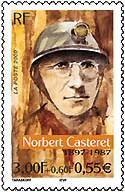Norbert Casteret
1897-1987


 Aven Marzal.
Aven Marzal.Norbert Casteret was born in 1897 in Saint Martory, Haute Garonne, and died in 1987 in Toulouse. For half a century, from 1920 to 1970, he was probably the most important speleologist of France. He is sometimes called father of modern speleology, although this is already applied to E.A. Martel, who lived one generation earlier. Working primarily on caves in his homeland Pyrenees, he not only explored caves, but also wrote numerous autobiographic books about his explorations, which were very popular for decades. During the 1950s and 1960s they were translated into many other languages.
Casteret was a very good sportsman, and one of his most famous saying is "Speleology is sport in commission of science". He was physically fit all his life, playing soccer, diving, skiing, rowing, pole vault and others. Also he was rather small and slim, which made him a very successful discoverer.
He started with some pretty dangerous explorations, where he dived naked into a siphon, only with water tight packed candle and matches. Later he writes in several books about this, and warns not to copy this dangerous lapse. After his first adventures he learned the techniques of caving from E. A. Martel. Martel, the founder of speleology wrote the foreword to his first book.
Unlike Martel, he was not a speleologist by profession. He studied and worked as a notary public. But he also studied prehistory at the Muséum d’Histoire Naturelle de Toulouse. This knowledge was very important for his later prehistoric discoveries.
At the Fontaine de Vaucluse, an important karst spring in the Provence, a museum named Le Monde Souterrain de Norbert Casteret exists. It shows cave exploration equipment and the mineral collection of Casteret.
Explorations
| 19-AUG-1897 | born in Saint Martory, Haute Garonne. |
| 1923 | Caverne de Montespan, Haute-Garonne, discovery of prehistoric sculptures. |
| 1926 | various caves in the Cirque de Gavarnie discovered, especially the Grotte Glacée Casteret. |
| 1927 | Rivière souterraine d’Izaut. |
| 1928 | Human remains, probably from Roman times, discovered in the Grotte de Girosp. |
| 1929 | Casteret discovered engravings in the Grotte d’Alquerdi. |
| 1930 | Discovery of the
 Grotte de Labastide. Grotte de Labastide.
|
| 1932 | first exploration of the Grotte Cigalère. |
| 1933 | La Grotte Dite de Peyort. Gouffre Martel, l’Ariège. |
| 1934 | cave explorations at Morocco. |
| 1936 | Grotte de Houaliech. |
| 1937 | Grotte de Labouiche, together with Joseph Delteil. |
| 1938 | Gouffre Grotte d’Esparros. |
| 1941-1947 | exploration of the Henne Morte. |
| 1947 | depth record -446 m in the Henne Morte. |
| 1950 | Casteret and his daughters Maude and Gilberte discovered five ice caves in the Cirque de Gavarnie. |
| 1952-1953 | Pierre Saint Martin. |
| 20-JUL-1987 | died in Toulouse. |
Bibliography
Casteret wrote more than 43 books, which made him very popular in the 1950s and 1960s. Here are the probably most important ones. Many of this books were translated into other languages. Dix ans sous terre (Ten Years Under the Earth) is still available in English, see the Books section.
- Norbert Casteret (1933):
Dix ans sous terre,
Librairie Académique Perrin, 22 black and white photographs, 3 diagrams, 270 page.
This is the first book of Casteret. It describes several campaigns between 1922 and 1933, for example his discovery of the prehistoric statues of the cave of Montespan and the discovery of the sources of the Garonne. Foreword by E. A. Martel. - Norbert Casteret (): Au fond des gouffres,
- Norbert Casteret (1940):
Mes cavernes,
Librairie Académique Perrin, 66 black and white photographs, 1 diagram, 276 pages
The third book starts with the exploration of the underground river of Labouiche in 1935 and ends with the study of the bats at Tignahustes in 1939.
- Norbert Casteret (1943): Édouard-Alfred Martel: Explorateur du monde souterrain, Gallimard (réédition numérique FeniXX), 270 pp. amazon
- Norbert Casteret (1949):
Exploration,
Librairie Académique Perrin, 46 black and white photographs, 2 diagrams, 274 pages.
Exploration of the Gouffre de la Henne-Morte between 1941 and 1947. - Norbert Casteret (1961):
Ma vie souterraine,
Memoires d’un Speleologue.
Editions Flammarion
- Norbert Casteret (1962):
Aventures sous terre,
volume 1: Flambeau au poing.
volume 2: Abimes et cavernes.
volume 3: Profondeurs.
Librairie Académique Perrin, 23 black and white photographs, 320 pages
- Norbert Casteret (1965): Muta, fille des cavernes,
- See also
 Search DuckDuckGo for "Norbert Casteret"
Search DuckDuckGo for "Norbert Casteret" Norbert Casteret - Wikipedia (visited: 25-NOV-2020)
Norbert Casteret - Wikipedia (visited: 25-NOV-2020) Norbert Casteret. A sort of official Casteret site, made by his daughter Gilberte Casteret. (
Norbert Casteret. A sort of official Casteret site, made by his daughter Gilberte Casteret. ( )
) Norbert Casteret
Norbert Casteret  (visited: 25-NOV-2020)
(visited: 25-NOV-2020) Norbert Casteret: Muta, fille des cavernes (
Norbert Casteret: Muta, fille des cavernes (
 )
) Internet Archive (visited: 25-NOV-2020)
Internet Archive (visited: 25-NOV-2020)

 Index
Index Topics
Topics Hierarchical
Hierarchical Countries
Countries Maps
Maps